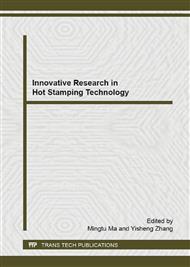p.280
p.290
p.297
p.301
p.305
p.309
p.314
p.318
p.322
Spring-Back Control in Automotive Door Inner Panel Stamping
Abstract:
The spring-back defect of the front door inner panel is a major technical issue during the automotive body manufacturing processes. The primary purpose of this study is to control the spring-back value of the door inner panel by optimizing geometric parameters of addendum surface and selecting appropriate forming process. The Inverse Approach is employed to analyze the formability of the panel and to acquire rapid amendment of the die face design. Two kinds of forming processes are conducted, respectively, one-step forming method and two-step forming method. The results show that the one-step forming process combining with the optimized addendum surface can reduce the spring-back amount of side wall regions on door panel less than 2mm. The proposed optimizing scheme was verified by multiple trial-producing.
Info:
Periodical:
Pages:
305-308
Citation:
Online since:
December 2014
Authors:
Keywords:
Price:
Сopyright:
© 2015 Trans Tech Publications Ltd. All Rights Reserved
Share:
Citation:


